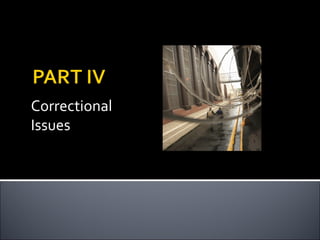
Correctional Issues: Special Populations and Juvenile Corrections
- 2. Special Populations and Juvenile Corrections
- 3. Elderly Prisoners Geriatric offenders Housing Medical care Programs Release
- 4. Prisoners with HIV/AIDS Higher rate of infection than general population ▪ High-risk behaviors ▪ IV drug use ▪ Needle sharing ▪ Unprotected sex
- 5. Prisoners with HIV/AIDS Segregation policies are controversial ▪ Advocates ▪ Prison violence decreases ▪ HIV-infected inmates benefit from removal from the general population ▪ Additional health care and programs more available ▪ Better living accommodations ▪ More staff support and specialized care
- 6. Prisoners with HIV/AIDS Safe environment for staff ▪ Correctional officers ▪ Breaking up fights ▪ Handling physically violent inmates ▪ Chance of virus transmission are reportedly low
- 7. Mentally Ill Prisoners Deinstitutionalization More likely among violent offenders Less likely among drug offenders Differs by age, race, and gender Sexual abuse, homelessness, incarcerated family member
- 8. Mentally Ill Prisoners Challenges for correctional officials ▪ More fights ▪ More rule violations ▪ Counseling ▪ Medication
- 9. Long-Term Prisoners Each life sentence costs taxpayers approximately $1 million “Get tough” sentences mean more non-violent long term inmates Not generally control problems
- 10. Long-Term Prisoners Three main principles for managing long-term inmates ▪ Maximize opportunities for the inmates to exercise choice in living conditions ▪ Create opportunities for meaningful living ▪ Help the inmates maintain contact with the outside world
- 11. The Problem of Youth Crime In a typical year, about… ▪ 1,100 youths under the age of 18 are arrested for homicide ▪ 4,200 for forcible rape ▪ 60,500 for aggravated assault Extremely serious juvenile crime is still rare
- 12. The History of Juvenile Corrections in the United States The Puritan Period The Refuge Period The Juvenile Court Period
- 13. The History of Juvenile Corrections in the United States The Juvenile Court Period ▪ Parens patriae ▪ Informality ▪ Individualization ▪ Intervention ▪ Delinquent, neglected, dependent children
- 14. The History of Juvenile Corrections in the United States The Juvenile Rights Period The Crime Control Period ▪ Racial, demographic, and economic changes
- 15. Why Treat Juveniles and Adults Differently? Juveniles are young and may easily change Juveniles have a high rate of “desistence” Juveniles’ families are an important part of their lives Juveniles are easily influenced by their peers Juveniles have little responsibility for others
- 16. The Problem of Serious Delinquency Normal delinquency Status offenses ▪ Runaway ▪ Truancy ▪ Ungovernable Age appropriate behavior Social context
- 17. Percentage of Petitioned Status Offense Cases Involving Female Offenders 1985–2002
- 18. Sanctioning Juvenile Offenders Fragmentation ▪ Courts ▪ Executive branch ▪ County ▪ State Other factors to consider
- 19. Sanctioning Juvenile Offenders Disposition of juvenile offenders Waiver Diversion Detention Juvenile probation Intermediate sanctions for juveniles Juvenile incarceration Juvenile aftercare
- 20. The Special Problem of Gangs Most gangs nonviolent Custodial facilities ▪ Control ▪ Management of inter-gang conflict Community settings ▪ Hostile competition for prosocial programming Operation Ceasefire, Boston
- 21. The Special Problem of Gangs Characteristics of Youth Who Belong to a Gang
- 22. The Future of Juvenile Justice Public policymakers Public opinion Juvenile waiver Tougher probation Middle ground
Notas do Editor
- Learning Objective One
- Learning Objective Two
- Learning Objective Two
- Learning Objective Two
- Learning Objective Three
- Learning Objective Three
- Learning Objective One
- Learning Objective One
- Learning Objective Four
- Learning Objective Five
- Learning Objective Five
- Learning Objective Five
- Learning Objective Six
- Learning Objective Seven
- Learning Objective Seven
- Learning Objective Seven
- Learning Objective Seven
- Learning Objective Seven
- Learning Objective Seven
- Learning Objective Eight